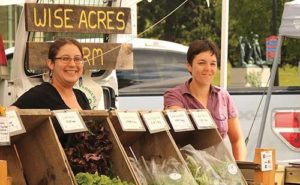 |
| Joy Trueworthy (left) and Brittany Hopkins raise MOFGA-certified organic vegetables on their Wise Acres Farm in Kenduskeag. Photo by Nicholas Navarre via the Maine Federation of Farmers’ Markets |
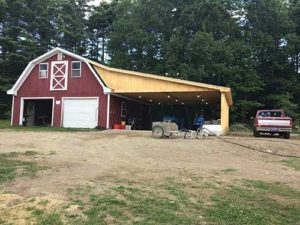 |
| The barn and packing area at Wise Acres |
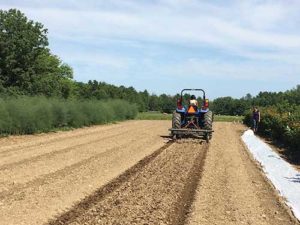 |
| Hopkins uses a Williams Tool for stale seedbedding (pictured here), cleaning up paths and for some blind cultivation of growing crops. |
 |
| Chisel plowing and incorporating cover crop residue breaks up the compaction caused by years of haying. |
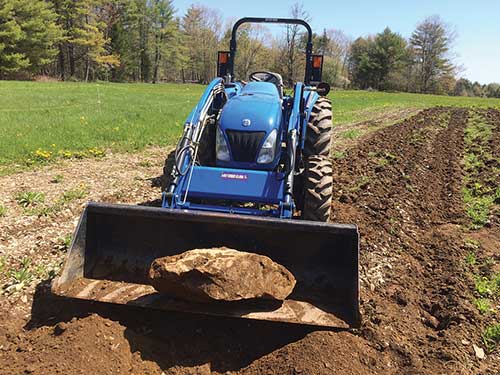 |
| Yes, Wise Acres has some rocks. |
By Sonja Heyck-Merlin
Maine has an abundance of land that has been retired from productive farming. As farming has become concentrated on large-scale operations sited on the best soils, smaller parcels are left behind. Forests encroach on the field edges, reclaiming cleared land. Most of these abandoned fields are undernourished and underproductive, but many are kept open by hay operations.
Landing in Kenduskeag
In the fall of 2011, Brittany Hopkins and her wife, Joy Trueworthy, purchased 40 such acres in the central Maine town of Kenduskeag. With 15 acres of open land bordered on three sides by forest, Hopkins, the principal farmer, began the process of regenerating the land, and in less than a decade has transformed it into a productive part of Penobscot County’s rural economy. Trueworthy, a self-employed lawyer, is also the self-proclaimed farmers’ market “weekend warrior.”
“Joy and I met in high school in Portland, Maine, and then both attended Smith College. After graduation we moved to New Jersey so that Joy could attend law school,” Hopkins says. During their years in New Jersey, Hopkins pursued a career in economic development and urban planning but concluded that she “didn’t like working in an office.” These experiences, combined with the imprinting of her rural Maine childhood participating in 4-H dairy goat shows, drew Hopkins and Trueworthy (also a Maine native) back to Maine after Trueworthy completed law school. The name of their Wise Acres Farm originates from Hopkins’ parents’ farm and homestead in southwestern Maine.
Before purchasing their land in Kenduskeag, Hopkins spent three growing seasons honing her skills as an apprentice and worker on three organic vegetable farms in central Maine: Peacemeal Farm in Dixmont, Fisher Farm in Winterport and Parker Family Farm in Newport. Committed to continuing her agricultural education, Hopkins enrolled in MOFGA’s two-year Journeyperson Program as she began breaking ground in Kenduskeag and establishing a business.
Recording and Crunching
As part of the Journeyperson Program, Trueworthy and Hopkins participated in the Farm Beginnings course – a series of intensive workshops designed to help beginning farmers develop a whole farm plan and to provide business planning tools necessary to implement the plan.
“In Farm Beginnings, I was introduced to Richard Wiswall’s method of enterprise budgeting and continue to use a modified version of the plan advocated by Wiswall,” Hopkins says. In Wiswall’s seminal work “The Organic Farmer’s Business Handbook,” he emphasizes the importance of tracking all estimated income and expenses associated with a specific enterprise to provide an estimate of its profitability.
After spending her first winters analyzing her records by sifting through stacks of paper and hand-written notes, Hopkins learned to use technology for enterprise budgeting. Between tablets, smartphones and software, she has developed a simple on-the-go record-keeping system that consolidates her seeding and planting history, field prep, inputs, harvest, labor demand and sales for their 2 acres of mixed vegetables.
Hopkins uses two software programs, Square and Airtable, to record this information. Airtable is a mobile-friendly app, part spreadsheet and part database, that helps her track crops from seeding to harvest. Each field and succession planting is entered into Airtable along with details such as dates seeded, row footage planted, amendments added and crop harvested.
Hopkins prefers Airtable to a spreadsheet because it’s more compatible with her smartphone, easier for her crew to collaborate on, and she appreciates its ability to extract specific crop data. For example she can filter Airtable to show only July 2019 carrot plantings along with the information relevant to those carrots. A drawback is that Airtable requires cell reception or wireless service.
Square is a mobile payment and point of sales app. Hopkins uses it on a tablet to track the sale of individual purchases at their three weekly farmers’ markets: Ellsworth, Waterville and Bangor. (Bangor is the only market they continue through the winter.) Before market she enters a price and photo of each crop into Square. At market she uses the touchscreen to select the crop and enter the quantity sold as she checks out customers. “Square eliminates mental math, makes it easier for new employees to participate, and allows me to calculate the amount not sold,” Hopkins says.
About using Square at market, Trueworthy adds, “Because there is no mental math, it’s easier to have substantive conversations with customers while ringing them up.”
The most difficult part of enterprise budgeting, Hopkins thinks, is tracking labor costs. Each year she selects two weeks to focus on this job, one early in the season and one late. In those two weeks she and her employees record how long it takes to complete every individual task. Then she uses the data to extrapolate labor costs for each crop-specific task.
Hopkins uses a third program, Excel, to analyze the output from Airtable and Square. This spreadsheet shows where her efforts are rewarded most and plays a large part in the reason her enterprise grossed $50,000 per acre under production in 2019.
Using the Data
By collecting and analyzing data, Hopkins can decide what and how much to grow. “Interestingly,” she says, “we have found that we didn’t need more land to grow production and sales. It has been more about better management of existing fields, season extension and crop choice.”
The current goal is to grow larger amounts of profitable crops and ones that do well on their site while still maintaining enough diversity for their farmers’ markets and 40-member Community Supported Agriculture (CSA) program.
“There’s a limit to how much we can pare down,” says Hopkins. “I think we’ve done it as much as we can, and I realize that our customers miss crops that we used to grow. It has still been a good choice for the economic sustainability of the farm and our sanity.”
Profitable crops are salad and baby greens mixes, Salanova, root crops, garlic, tomatoes, eggplant, peppers, cucumbers, zucchini, summer squash and brassicas. Break-even crops include winter squash, onions, green beans, asparagus, strawberries and raspberries. These are the crops that Hopkins has deemphasized in the past few years, growing just enough to add some color and variety to markets and CSA shares. Annually they plant 600 strawberry plants and maintain 300 row feet of raspberries. They do not grow corn, shell peas or potatoes.
Of their 4 open acres, which include two Ledgewood brand high tunnels (a 21-by-104-foot and a 30-by-152-foot) and two 150-foot caterpillars, about half is cultivated each season. The remaining acreage is cover cropped and fallowed. In 2020 the smaller high tunnel will grow early spring greens, followed by tomatoes. The larger high tunnel, built in 2019, will grow diverse crops, with an emphasis on late-season greens.
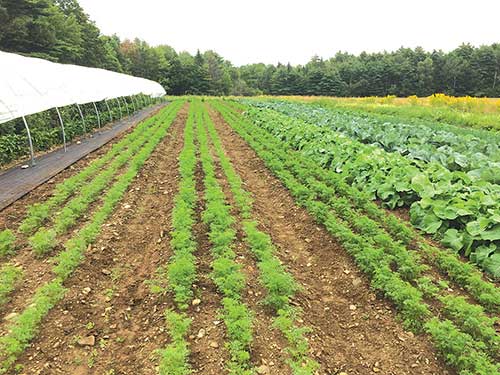 |
| Vegetables grow in 150-foot rows in 42-inch-wide unraised beds. |
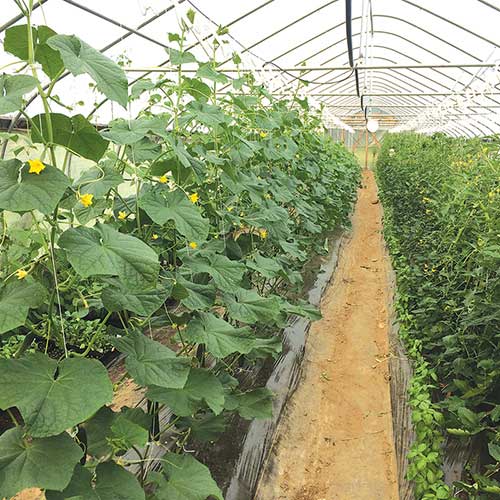 |
| Late-season crops, including cucumbers, grow in one Ledgewood high tunnel. |
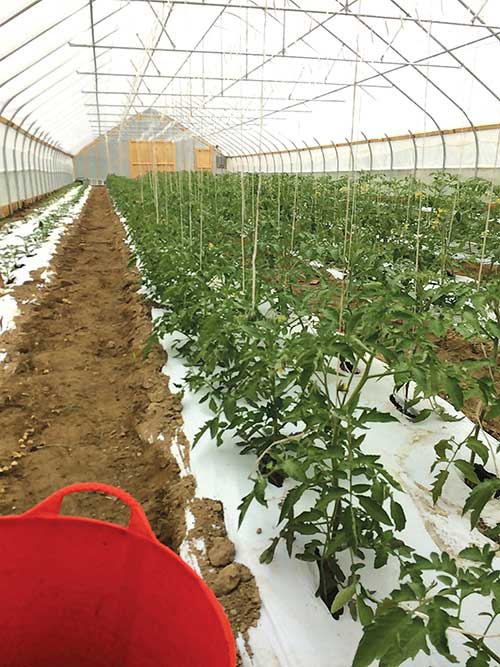 |
| Tomatoes follow spring greens in a second Ledgewood high tunnel. |
The growing plots at Wise Acres average one-quarter to three-quarters acre and are standardized with 150-foot rows and 42-inch-wide unraised beds. Tire tracks from their only tractor, a 55 horsepower New Holland T2410, form the pathways. Primary soil types are Thorndike and Dixmont shaley silt loam, and the ground is laden with rocks of all sizes. Regarding the rocks Hopkins says, “Visitors come to the farm and say, ‘I don’t know how you put up with this.’” The good thing about their soils, however, is that they are well-drained.
Primary tillage tools are a 6-foot rototiller and a chisel plow. Hopkins says, “The chisel plow has been critical to breaking up the compaction caused by years of haying.” Each field gets chisel plowed and rototilled each year. She acknowledges that rototilling is a controversial tillage method, but she believes that between the combination of her lighter soil and a high ground speed, she can make a decent seedbed without compromising the soil structure.
Ideally beds are prepped ahead of time to allow for stale seedbedding – a management practice in which weed seeds just below the soil surface are allowed to germinate and then are killed before or soon after seeding a crop. Hopkins uses a Williams Tool to accomplish this. The tool features a gang of light S-shaped spring tines that she drags across the surface of each bed to kill freshly germinated weed seeds.
After stale seed-bedding, she either direct seeds or transplants crops. Primary direct-seeded crops are cutting greens, herbs and root crops. For direct seeding, she has depended on an Earthway seeder but recently bought a Jang precision seeder. Hopkins warns that with the Jang, “you have to make sure every seed germinates; otherwise you end up with a sparse crop.” She has found the Jang to be most effective for radishes, salad turnips and spinach.
Before transplanting field crops, which include lettuces, brassicas, cucurbits, alliums and nightshades, Hopkins marks the beds with a Two Fat Cats dibbler. This Vermont-made nonelectric tool has an offset handle and is rolled down the bed, leaving an impression in the soil to accurately space transplants. She adds or removes wheels and spikes depending on how many rows and what in-row spacing are desired.
Hopkins bought a legacy of depleted soil, and she struggled with low yields in her first few years. However, she has consciously decided not to use any manure and relies on cover cropping and a 5-4-3 organic pelletized fertilizer to meet the nutrient needs of crops. She applies the fertilizer with a cone broadcast spreader. Onions and garlic are sidedressed in-row by hand.
Her main reason for excluding compost and manure, she says, “is that we are blessed with a low weed seed bank, and I don’t want to import any weed seeds.” Her crew manages the weeds that do grow with 7-inch collinear hoes and maintains pathways with sweeps attached to the sides of the Williams Tool. The weed pressure is so low though that Hopkins says her crew (typically one part-time and two-full time employees) doesn’t ever fully hone its hoe weeding skills.
“We usually have a few long-season plantings that get away from us and need to be laboriously rescue-weeded by hand,” Hopkins acknowledges. In August typically, they also diligently rogue any weeds from beds still in production that are “threatening to rain weed seed.” Hopkins also rogues seedy weeds as beds transition from harvest to autumn cover crops.
Trying Times
Small-acreage mixed vegetable farms such as Wise Acres are proliferating across Maine and beyond for good reason. On a small footprint, with modest infrastructure and equipment requirements, a determined individual such as Hopkins can take an old hay field and methodically transform the land, promote biodiversity and grow nutrient-dense food. Hopkins finds this venture to be “an endless allure and an endless challenge.”
Although farming is inherently challenging, Hopkins takes deliberate steps to hedge the risks. With the help of cost sharing from the Natural Resources Conservation Service, she can now irrigate. High tunnels, also obtained through cost-share, enable her to extend the growing season and prevent diseases such as late blight on tomatoes. By growing diverse vegetable crops, she can survive crop failures.
As Hopkins was beginning to ratchet up the 2020 growing season, she and other farmers whose economy depends on farmers’ markets were facing an uncertain season because of the COVID-19 virus. Maine’s many farmers’ markets, deemed essential services by the state, were expected to continue under special guidelines intended to prevent the spread of the virus.
Hopkins, like all of us, lacks the knowledge to know if the most serious phase of the virus will continue for two, four, six months or more, and without knowing that, she says, “It’s hard to figure out how to respond.”
After nearly a decade of attending farmers’ markets, the Wise Acres stand draws long lines of customers. Hopkins was creating a system that would allow her to attend markets yet maintain physical distancing protocols. Using Square, she was setting up an online store where customers preorder and prepay. Orders would then be packed at the farm and picked up at market. She was also considering prepacking some boxes, similar to a CSA share, to make available at market.
“As long as physical distancing measures are in place, we plan to stick with some form of preordering and grab-and-go boxes to minimize handling payments and speed up transaction time so customers can come and go quickly,” Hopkins says.
If physical distancing persists through the busiest part of the season, she anticipates the need to focus on a few sizes and types of “farmer’s choice” CSA-style boxes to help minimize traffic and interaction at market and to limit the hours of prepacking logistics needed before market. “Once it gets busy,” Hopkins says, “I don’t think we’ll have the capacity to pack customized orders for each customer. We’ll have to streamline the process.”
While the COVID-19 pandemic presents an unprecedented challenge, Hopkins says, “We still envision farmers’ markets being our main distribution sites. I feel strongly that farmers’ markets are important food access points. They are an essential part of the food system that I hope we can continue to operate during this pandemic.”
About the author: Sonja Heyck-Merlin is a regular feature writer for The MOF&G. She and her family own and operate an organic dairy farm in Charleston, Maine.
